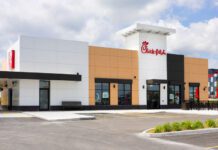By Laura Pratt
The Challenge
There’s much to consider when undertaking a modern restaurant design. Along with aesthetics and practicalities, designers need to also think about the needs of an important contingent of their clientele with accessible elements. Many of these features are required by law; others are gestures of compassion. Either way, they’re a hurdle for anyone charged with the massive task of designing a restaurant.
Consider, for example, the challenge Charlottetown’s Founders’ Food Hall & Market took on in 2019 when it elected to transform a formidable former industrial railway building into a waterfront destination for Spud Islanders and P.E.I. visitors — including a steady stream of cruise passengers.
Universal design (UD) is an approach to the creation of products and environments ensuring access and equity in experience for all users, regardless of their needs. In the context of restaurants, the application of UD principles includes spatial considerations calling for floor plans developed to promote easy navigability for people using a wheelchair or other mobility aids.
According to the Center for Universal Design, UD is “the design of products and environments to be usable by all people, to the greatest extent possible, without the need for adaptation or specialized design.” Any UD product or environment needs to be accessible, usable, and inclusive. The seven principles of UD are: equitable use, flexibility in use, simple and intuitive, perceptible information, tolerance for error, low physical effort, size and space for approach and use.
The Canadian Charter of Rights and Freedoms guarantees the right to the equal protection and equal benefit of the law without discrimination and, in particular, discrimination on the basis of disability. And the Canadian Human Rights Act recognizes that all individuals should have an opportunity equal with other individuals to make for themselves the lives that they are able and wish to have and to have their needs accommodated without discrimination and, in particular, discrimination on the basis of disability.
Building on these pieces of legislation, Parliament adopted the Accessible Canada Act (ACA) in 2019 “to ensure a barrier-free Canada,” by January 1, 2040. This involves identifying, removing, and preventing barriers in federal jurisdiction in such priority areas as “the built environment.”
Beyond these acts, disability regulations are largely determined at a provincial/territorial level, and while they share certain elements, they also have distinctions.
In British Columbia, for example, accessibility is an important part of the BC Building Code, which sets the rules for the design and construction of new buildings; accessibility code requirements help ensure buildings are designed and constructed so everyone can reasonably approach, enter, and exit them; and move safely throughout them to use the facilities and services.
In Nova Scotia, the updated Nova Scotia Building Code requires any new restaurants be accessible to everyone, with food-safety permit granting dependent upon their having accessible entrances, pathways and washrooms.
In Manitoba, meanwhile, the Accessibility for Manitobans Act calls for “barrier-free access to goods and services” and requires that any aspect of organization’s “built environment intended to facilitate barrier-free access to the goods or services it provides [be] available for use in the intended manner.”
In Saskatchewan, the Saskatchewan Accessibility Act, enacted in 2021 after a long period of anticipation during which many complaints were lodged about people’s physical, attitudinal, and systemic challenges when trying to access public spaces, promises a barrier-free province, including in the built environment.
In Alberta, restaurants must be accessible to people who use wheelchairs, though the Alberta Safety Codes Act’s requirement of a barrier-free design of new buildings and premises excludes many older businesses, which remain less accessible for people with physical disabilities. And in Ontario, where 2.6 million people have a disability and more than 40 per cent of the population is over 65, the customer-service standard under the Accessibility for Ontarians with Disabilities Act outlines requirements for service providers to make their facilities accessible for customers with disabilities. The first province, and one of the world’s first jurisdictions to enact specific legislation establishing a goal and time-frame for accessibility, Ontario’s the first jurisdiction to establish standards in the design of public spaces. This province has pledged full accessibility by 2025.
The Opportunity
Founders’ Hall, the two-level European-style food hall that is the jewel of the Charlottetown waterfront, is more than 100 years old. It measures 16,000 sq. ft., and has a capacity for 500 people. Here, visitors can choose from among the offerings of 18 local vendors, including owner-operated purveyors of paninis, vegan comfort dishes, Turkish street food, French Caribbean cuisine, and the island’s only sushi burrito. And for those among their ranks whose dining-out requirements include those acknowledging physical limitations, a range of measures is in place.
Because Founders’, which resides on the Port of Charlottetown’s properties, services a regular torrent of patrons who flow from the cruiseships that dock in its harbour, the operation is extraordinarily accommodating to the range of ability levels these passengers — many elderly and infirm — possess. “We say Founders’ is for everyone,” says Jennifer Blair, Founders’ Marketing and Event manager. “And we do our best to make sure there are no physical or prestige barriers so everyone can enjoy themselves here.”
The proof begins outside the building, where a boardwalk leads from waterfront to retail space. It was important for designers to make the dining hall’s exterior features flat and even, along with all its parking lots, curbs, and ramps. A rope runs along the boardwalk, strung between the posts, to assist people who need something to hold onto to guide their uncertain steps toward the warehouse-style space.
Wheelchair-accessible automated doors allow visitors to gain access to the building with the push of a button. Inside, the main floor sports a wide hallway that designers ensured left adequate space for an unobstructed flow of traffic — wheelchair users and walkers alike — and to accommodate the comfort and ease of movement of everyone. The flooring is smooth and even. The open mezzanine level is large and airy with high ceilings and big windows. The seating, opposite the food vendors, is food-hall, cafeteria-style. All the tables are wheelchair accessible and patrons can move them around to accommodate walkers and wheelchairs and make room for passage as needed. The tables are at a height that allows for the wheelchair user to sit comfortably and to move the chairs around to accommodate different groups. Hallways to the washroom are wide, as are the cubicles themselves. Sinks are at an appropriate height.
Different legislation exists across Canada when it comes to accessibility, so operators need to do their research in order to ensure that their restaurants are meeting the standards that will allow them to be enjoyed by all.


















